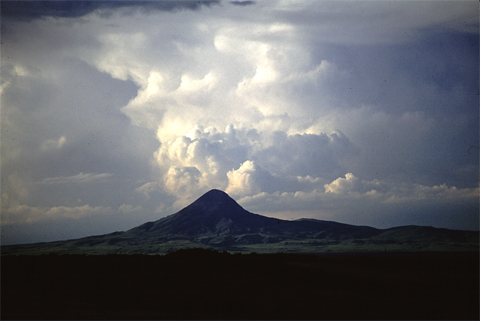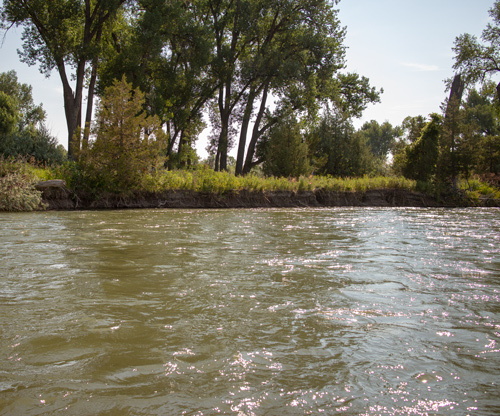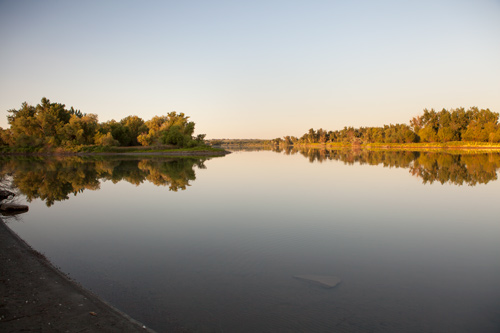Lewis and three others move up the Marias River hoping to find a northern tributary. A creek running from Tower Mountain appears to be too small to extend the boundaries of the Louisiana Territory.
Moving down the Yellowstone, Clark and his group finally reach cottonwood trees large enough for making canoes. They establish a canoe camp near present Laurel, Montana and attend to Pvt. Gibson who was seriously wounded yesterday.
Sgt. Ordway and nine men reach the upper portage camp above the Great Falls of the Missouri where Sgt. Gass and his detachment have been waiting. They beach the dugouts in preparation for the portage around the falls.[1]For more on the captains’ strategy and various groups after leaving Travelers’ Rest, see Dividing Forces at Travelers’ Rest.
Gibson Seriously Wounded
by Yellowstone Public Radio[2]Originally aired weekdays by Yellowstone Public Radio during the Bicentennial observance of 2003-2006. Narrated by Hal Hansen. Scripts by Whit Hansen and Ed Jacobson. Produced by Leni Holliman. © … Continue reading
Lewis Takes Observations
Looking for Tributaries
faring that a fork of this stream might fall in on the Northside between this place and the point to which I had ascended it, I directed Drewyer who was with me on my former excurtion, and Joseph Fields to decend the river early in the morning to the place from whence I had returned, and examine whether any stream fell inn or not.
—Meriwether Lewis
Moving Up the Marias
having completed my observation of the sun’s meridian Altitude we set out, ascended the river hills having passed the river and proceeded through the open plains up the N. side of the river 20 miles and encamped.
—Meriwether Lewis
The Tower Mountain
there is but little running water in this creek at present, it’s bed is about 30 yds. wide and appears to come from the broken Mountains so called from their raggid and irregular shape there are three of them extending from east to West almost unconnected, the center mountain terminates in a conic spire and is that which I have called the tower mountain
—Meriwether Lewis
Weather Diary (Lewis)
State of the weather at rise
Wind at rise
State of the weather at 4 P. M. Wind at 4 P. M. fair S E fair N E —Meriwether Lewis
Clark’s Yellowstone Canoe Camp[3]This is the location of Clark’s Yellowstone Canoe Camp as identified by Ralph Saunders, Clark’s Journey Through Stillwater County, Montana (Billings: Self-published, 2006).
© 24 July 2017 by Kristopher K. Townsend. Permission to use granted under the Creative Commons Attribution-Share Alike 4.0 International license.
Clark Finds a Canoe Camp
Gibson Seriously Wounded
I rose early and dressed Gibsons wound. he Slept but very little last night and complains of great pain in his Knee and hip as well as his thy. I had the Strongest and jentlesst Horse Saddled and placed Skins & blankets in Such a manner that when he was put on the horse he felt himself in as easy a position as when lying.
Gibsons thy became So painfull that he could not Set on the horse after rideing about 2 hours and a half I directed Sergt Pryor and one man to continue with him under the Shade of a tree for an hour and then proceed on to the place I Should encamp
—William Clark
A Search for Wild Ginger
I derected Shields to keep through the thick timber and examine for a tree sufficently large & Sound to make a Canoe, and also hunt for Some Wild Ginger for a Poltice for Gibsons wound. he joined me at dinner with 2 fat Bucks but found neither tree or Ginger. he informed me that 2 white bear Chased him on horsback, each of which he Shot from his horse &c.
—William Clark
Finding Suitable Trees
at dark I returned to Camp Sergt. Pryor had arived with gibson. after my arival at this place the hunters killed Seven Elk, four Deer, and I wounded a Buffalow very badly . . . . Shabono [Charbonneau] informed me that he Saw an Indian on the high lands on the opposit Side of the river
—William Clark
Weather Diary (Clark)
State of the weather at Sun rise Wind at Sun rise State of the weather at 4 P. M Wind at 4 P M. fair N W fair S E Saw the 1st Grape vine of the dark purple kind the grape nearly grown
—William Clark[4]To assist the reader of this web page, the date column is omitted and some abbreviations have been spelled out.
White Bear Sunrise
Below the White Bear Islands, 2 July 2013. © by Kristopher K. Townsend. Permission to use granted under the Creative Commons Attribution-Share Alike 4.0 International license.
Gass Waits for Ordway
The weather continues pleasant and most of the men are employed in dressing skins, as we have got all ready for crossing the portage as soon as the canoes arrive.
—Patrick Gass
Ordway Arrives
Arriving at the White Bear Islands
on about 3 P. M. we arived at the white bear Camp at the head of the portage. Sergt. Gass and five more of the party were Camped here.
—John Ordway
Beaching the Canoes
we took our baggage out of the canoes and halled them out to dry &C. the Musquetoes verry troublesome indeed much worse than they were last year.—
—John Ordway
Experience the Lewis and Clark Trail
The Lewis and Clark Trail Experience—our sister site at lewisandclark.travel—connects the world to people and places on the Lewis and Clark Trail.
Plan a trip related to July 19, 1806:
- Tiber Dam on the Marias (Lewis)
- Bear Paw Battlefield (Lewis)
- Billings, Montana (Clark)
- Three Forks to Billings Driving Tour (Clark)
- Upper Portage Camp Overlook (Gass and Ordway)

Clark’s Canoe Camp on the Yellowstone is a High Potential Historic Site along the Lewis and Clark National Historic Trail managed by the U.S. National Park Service. The site is on private property.
The Great Falls Portage is a High Potential Historic Site along the Lewis and Clark National Historic Trail managed by the U.S. National Park Service. It includes Sulphur Springs (open to the public) and Lower Portage Camp site (private land), and the Upper Portage Camp Overlook.
Notes
| ↑1 | For more on the captains’ strategy and various groups after leaving Travelers’ Rest, see Dividing Forces at Travelers’ Rest. |
|---|---|
| ↑2 | Originally aired weekdays by Yellowstone Public Radio during the Bicentennial observance of 2003-2006. Narrated by Hal Hansen. Scripts by Whit Hansen and Ed Jacobson. Produced by Leni Holliman. © 2003 by Yellowstone Public Radio. |
| ↑3 | This is the location of Clark’s Yellowstone Canoe Camp as identified by Ralph Saunders, Clark’s Journey Through Stillwater County, Montana (Billings: Self-published, 2006). |
| ↑4 | To assist the reader of this web page, the date column is omitted and some abbreviations have been spelled out. |





